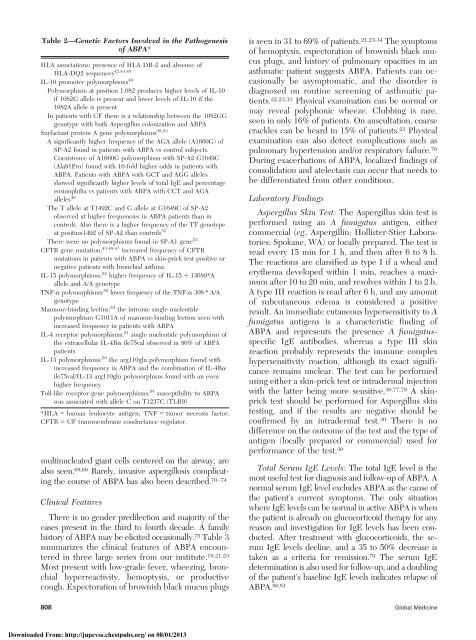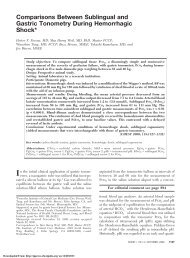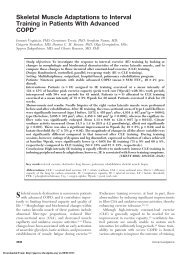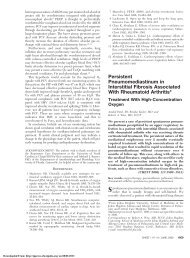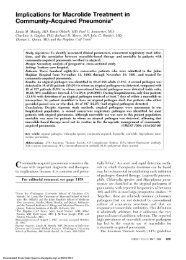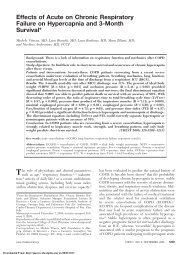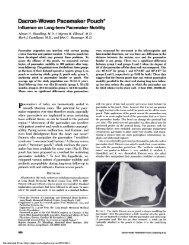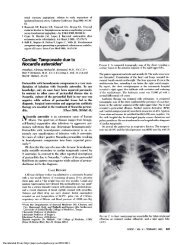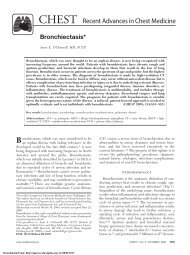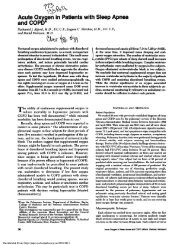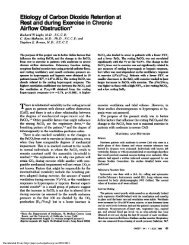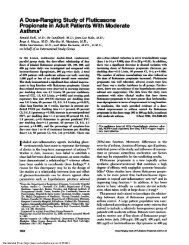Allergic bronchopulmonary aspergillosis - CHEST Publications ...
Allergic bronchopulmonary aspergillosis - CHEST Publications ...
Allergic bronchopulmonary aspergillosis - CHEST Publications ...
Create successful ePaper yourself
Turn your PDF publications into a flip-book with our unique Google optimized e-Paper software.
Table 2—Genetic Factors Involved in the Pathogenesis<br />
of ABPA*<br />
HLA associations: presence of HLA DR-2 and absence of<br />
HLA-DQ2 sequences 42,44,45<br />
IL-10 promoter polymorphisms 49<br />
Polymorphism at position 1,082 produces higher levels of IL-10<br />
if 1082G allele is present and lower levels of IL-10 if the<br />
1082A allele is present<br />
In patients with CF there is a relationship between the 1082GG<br />
genotype with both Aspergillus colonization and ABPA<br />
Surfactant protein A gene polymorphisms 48,53<br />
A significantly higher frequency of the AGA allele (A1660G) of<br />
SP-A2 found in patients with ABPA vs control subjects.<br />
Coexistence of A1660G polymorphism with SP-A2 G1649C<br />
(Ala91Pro) found with 10-fold higher odds in patients with<br />
ABPA. Patients with ABPA with GCT and AGG alleles<br />
showed significantly higher levels of total IgE and percentage<br />
eosinophilia vs patients with ABPA with CCT and AGA<br />
alleles 48<br />
The T allele at T1492C and G allele at G1649C of SP-A2<br />
observed at higher frequencies in ABPA patients than in<br />
controls. Also there is a higher frequency of the TT genotype<br />
at position1492 of SP-A2 than controls 53<br />
There were no polymorphisms found in SP-A1 gene 53<br />
CFTR gene mutation: 43,46,47 increased frequency of CFTR<br />
mutations in patients with ABPA vs skin-prick test positive or<br />
negative patients with bronchial asthma<br />
IL-15 polymorphisms: 52 higher frequency of IL-15 13689*A<br />
allele and A/A genotype<br />
TNF- polymorphisms: 52 lower frequency of the TNF- 308 * A/A<br />
genotype<br />
Mannose-binding lectins: 53 the intronic single nucleotide<br />
polymorphism G1011A of mannose-binding lection seen with<br />
increased frequency in patients with ABPA<br />
IL-4 receptor polymorphisms: 51 single nucleotide polymorphism of<br />
the extracellular IL-4R ile75val observed in 80% of ABPA<br />
patients<br />
IL-13 polymorphisms: 50 the arg110gln polymorphism found with<br />
increased frequency in ABPA and the combination of IL-4R<br />
ile75val/IL-13 arg110gln polymorphism found with an even<br />
higher frequency<br />
Toll-like receptor gene polymorphisms: 54 susceptibility to ABPA<br />
was associated with allele C on T1237C (TLR9)<br />
*HLA human leukocyte antigen; TNF tumor necrosis factor;<br />
CFTR CF transmembrane conductance regulator.<br />
multinucleated giant cells centered on the airway, are<br />
also seen. 68,69 Rarely, invasive <strong>aspergillosis</strong> complicating<br />
the course of ABPA has also been described. 70–74<br />
Clinical Features<br />
There is no gender predilection and majority of the<br />
cases present in the third to fourth decade. A family<br />
history of ABPA may be elicited occasionally. 75 Table 3<br />
summarizes the clinical features of ABPA encountered<br />
in three large series from our institute. 19,21,23<br />
Most present with low-grade fever, wheezing, bronchial<br />
hyperreactivity, hemoptysis, or productive<br />
cough. Expectoration of brownish black mucus plugs<br />
is seen in 31 to 69% of patients. 21,23,34 The symptoms<br />
of hemoptysis, expectoration of brownish black mucus<br />
plugs, and history of pulmonary opacities in an<br />
asthmatic patient suggests ABPA. Patients can occasionally<br />
be asymptomatic, and the disorder is<br />
diagnosed on routine screening of asthmatic patients.<br />
22,23,33 Physical examination can be normal or<br />
may reveal polyphonic wheeze. Clubbing is rare,<br />
seen in only 16% of patients. On auscultation, coarse<br />
crackles can be heard in 15% of patients. 23 Physical<br />
examination can also detect complications such as<br />
pulmonary hypertension and/or respiratory failure. 76<br />
During exacerbations of ABPA, localized findings of<br />
consolidation and atelectasis can occur that needs to<br />
be differentiated from other conditions.<br />
Laboratory Findings<br />
Aspergillus Skin Test: The Aspergillus skin test is<br />
performed using an A fumigatus antigen, either<br />
commercial (eg, Aspergillin; Hollister-Stier Laboratories;<br />
Spokane, WA) or locally prepared. The test is<br />
read every 15 min for 1 h, and then after 6 to 8 h.<br />
The reactions are classified as type I if a wheal and<br />
erythema developed within 1 min, reaches a maximum<br />
after 10 to 20 min, and resolves within 1 to 2 h.<br />
A type III reaction is read after 6 h, and any amount<br />
of subcutaneous edema is considered a positive<br />
result. An immediate cutaneous hypersensitivity to A<br />
fumigatus antigens is a characteristic finding of<br />
ABPA and represents the presence A fumigatusspecific<br />
IgE antibodies, whereas a type III skin<br />
reaction probably represents the immune complex<br />
hypersensitivity reaction, although its exact significance<br />
remains unclear. The test can be performed<br />
using either a skin-prick test or intradermal injection<br />
with the latter being more sensitive. 30,77,78 A skinprick<br />
test should be performed for Aspergillus skin<br />
testing, and if the results are negative should be<br />
confirmed by an intradermal test. 30 There is no<br />
difference on the outcome of the test and the type of<br />
antigen (locally prepared or commercial) used for<br />
performance of the test. 30<br />
Total Serum IgE Levels: The total IgE level is the<br />
most useful test for diagnosis and follow-up of ABPA. A<br />
normal serum IgE level excludes ABPA as the cause of<br />
the patient’s current symptoms. The only situation<br />
where IgE levels can be normal in active ABPA is when<br />
the patient is already on glucocorticoid therapy for any<br />
reason and investigation for IgE levels has been conducted.<br />
After treatment with glucocorticoids, the serum<br />
IgE levels decline, and a 35 to 50% decrease is<br />
taken as a criteria for remission. 79 The serum IgE<br />
determination is also used for follow-up, and a doubling<br />
of the patient’s baseline IgE levels indicates relapse of<br />
ABPA. 80,81<br />
808 Global Medicine<br />
Downloaded From: http://jupcvss.chestpubs.org/ on 08/01/2013


